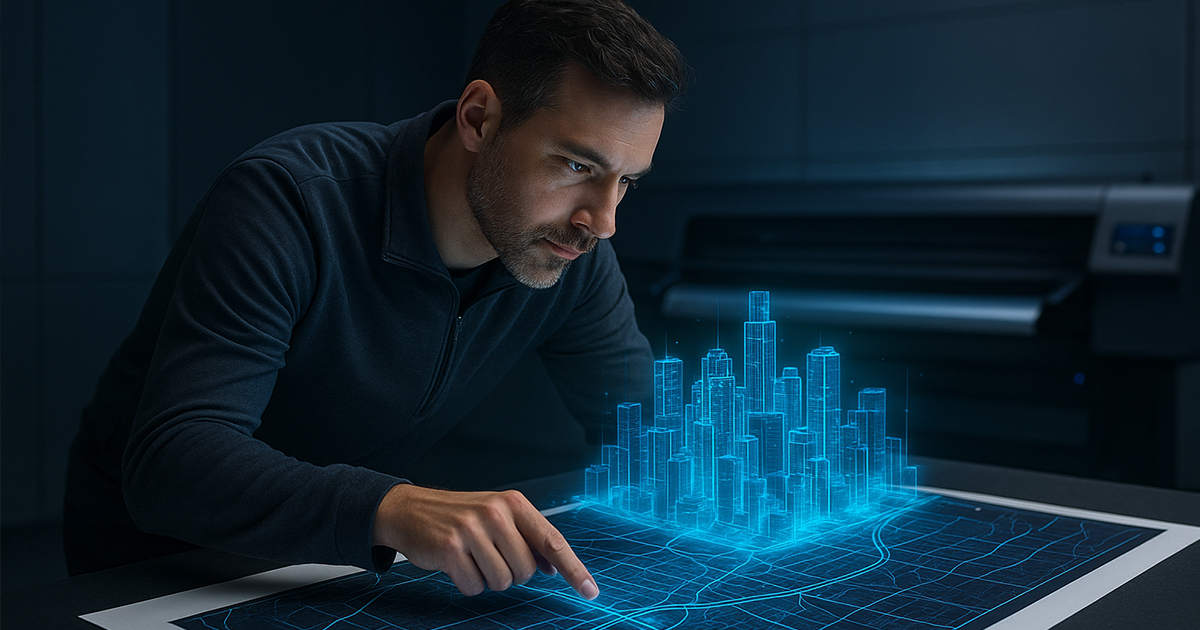Remember watching Harry Potter’s moving newspapers for the first time? What seemed like pure magic then might just be Tuesday morning at your local print shop in 2035. While we can’t predict the future with certainty, the trends emerging today paint a fascinating picture of what large format printing could become in just a decade.
Let’s take a journey into the realm of possibilities—some wild, some already happening, all potentially game-changing for how we think about printed graphics.
When Print Meets Magic: The Hybrid Revolution
Imagine this scenario: You’re walking through a stadium concourse when the sponsor banner on the wall suddenly comes alive. The printed graphic remains crisp and beautiful, but LED elements embedded within the material begin pulsing with team colors as your team scores. It’s not a digital screen—it’s still a printed banner, but one that bridges the physical and digital worlds.
This hybrid digital-physical integration might sound like something from a sci-fi movie, but the technology is already emerging. Picture printed graphics that can display real-time information while maintaining the durability and cost-effectiveness we love about traditional large format printing. A restaurant menu board that updates prices instantly while keeping its printed aesthetic. A trade show backdrop that morphs its messaging based on who’s approaching the booth.
These “living graphics” could offer the permanence and environmental benefits of print with just a touch of digital magic. No more expensive LED walls that consume massive amounts of energy—just smart printed materials that know when to come alive.
The Sustainability Crystal Ball
What if environmental regulations completely reshape how we think about graphics? Imagine walking into a print shop in 2035 where the question isn’t “What do you want to print?” but “How many times will you use it?”
We might see a world where every graphic is designed for multiple lives. That trade show backdrop could transform into a retail display, then become building wrap material, and finally get recycled into new substrates. It’s like having materials that adapt to exactly what’s needed, whenever it’s needed.
Print shops could become material libraries where graphics are checked out, used, returned, and transformed for the next customer. Imagine subscription models where companies pay for access to refreshed graphics rather than owning them outright. Your stadium graphics could update seasonally while the base materials get reused across multiple venues.
The AI Printing Assistant Revolution
Picture this: You upload a blurry image for a building wrap, and instead of getting an apologetic call about resolution issues, an AI system instantly enhances the image, optimizes it for the viewing distance, adjusts colors for outdoor lighting, and even suggests improvements for maximum visual impact—all before a human even sees the file.
This AI printing assistant could become like having a master craftsperson working 24/7, catching problems before they happen and optimizing every job for perfection. Equipment maintenance schedules itself, color profiles adjust automatically, and quality issues get flagged before the first inch of material runs through the printer.
The “Amazon Prime” Expectation
What if customers start expecting print with the same speed as food delivery? “I need a 40-foot banner in two hours, and here’s the tracking number so I can watch it being produced.”
We might see micro-fulfillment networks where smaller print operations scattered throughout cities can produce graphics locally, eliminating shipping time and reducing environmental impact. Your stadium banner gets printed at the facility closest to the venue, assembled on-site, and installed the same day.
Materials That Think for Themselves
Imagine materials that change color based on temperature, heal minor scratches automatically, or display different messages depending on the time of day. We’re already seeing early versions of smart materials—what if they become mainstream?
Picture building wraps that automatically adjust their appearance for maximum visibility throughout the day, or floor graphics that change color to guide traffic flow during different events. It’s like having materials with built-in intelligence, adapting to their environment without human intervention.
The Experience Economy Shift
What if print shops evolve into creative experience centers? Instead of just taking orders, they become partners in solving visual communication challenges. Virtual reality previewing becomes standard—customers can “walk through” their graphics before production, experiencing exactly how a stadium banner will look from the cheap seats or how a retail display will appear in different lighting.
The successful print shop of 2035 might look more like a design studio crossed with a technology lab, where technical expertise meets creative problem-solving.
Reality Check: The Fun of Uncertainty
Of course, predicting the future is notoriously tricky. Remember when we all thought we’d have flying cars by now? Some of these possibilities might happen faster than expected, others might take decades, and some might never materialize at all.
What’s exciting is that many of these “future” concepts are already emerging in early forms. The seeds of 2035’s print shop are being planted today, and the companies experimenting with these possibilities now will likely shape what actually happens.
The most thrilling part? The future probably holds surprises we can’t even imagine yet. Just like those moving newspapers in Harry Potter seemed impossible until suddenly they weren’t, the print shop of 2035 might contain magic we haven’t even dreamed of yet.
At XL Digital, we’re keeping our eyes on these emerging possibilities while staying grounded in delivering exceptional results today. Whether the future brings us magical hybrid displays or simply better ways to produce beautiful graphics, we’re committed to being ready for whatever comes next. After all, the best way to predict the future is to help create it—one innovative project at a time.

